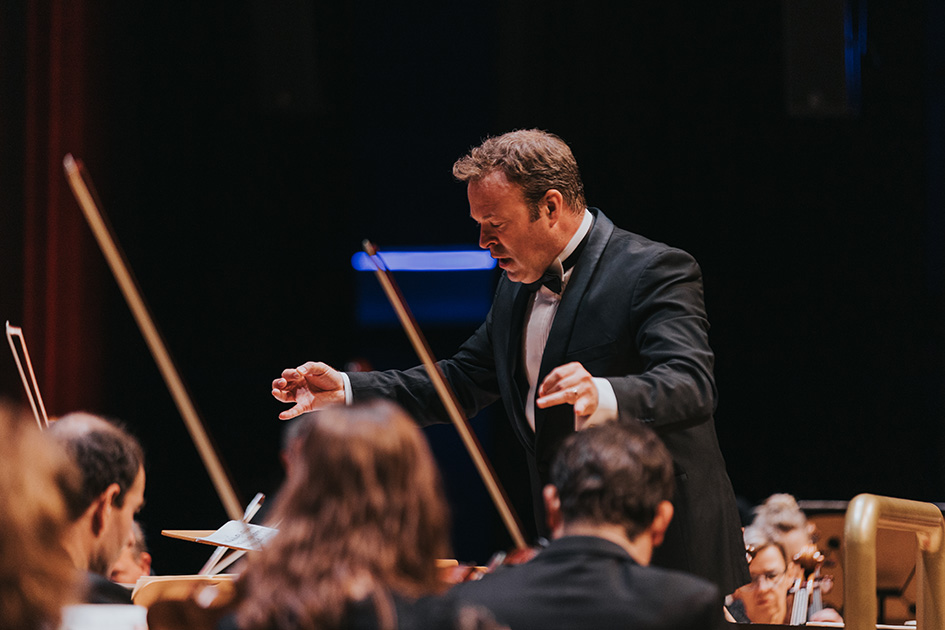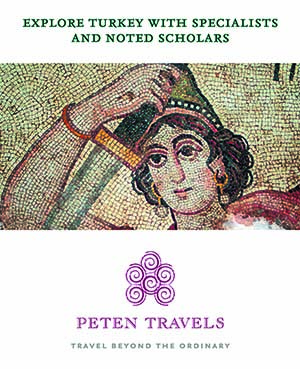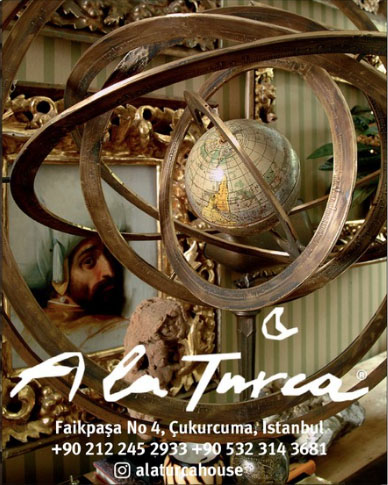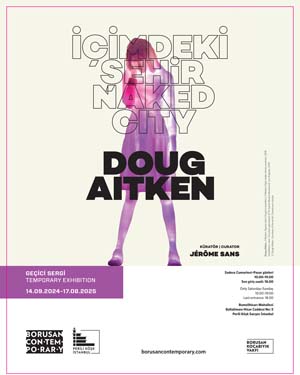On July 6 I attended a concert by the Orchestre National de Metz Grand Est at Istanbul's Cemal Reşit Rey Concert Hall. The event was in aid of the Enstrüman Destek Fonu (Instrument Support Fund), a campaign organised by the İKSV to buy instruments for students and teachers of music who lost their instruments (and heaven knows what else) in the earthquakes that struck southeast Anatolia on February 6. The beneficiaries, in addition to university-age students attending conservatoires, are boys and girls studying music at the Fine Arts Anatolian Lycées (Güzel Sanatlar Anadolu Liseleri) which give students a grounding in art or music as a preparation for a career in an arts-related profession. The concert, appropriately entitled Umut Notaları / Les Notes de l’Espoir – Notes of Hope – was organised jointly by the Institut Français de Turquie and the İKSV.
As reported in the Daily Sabah by Buse Keskin, who was at the pre-concert press conference at the Palais de France, the fund provides significant support to cultural development in the region. According to Yeşim Gürer of the İKSV, applications have been received from more than 800 music students and instructors in 11 provinces. 'So far we have delivered instruments to over 180 students and teachers,' she said in her speech. 'The goal is to provide new instruments to over 500 students and instructors by the end of the year.' Sylvie Lemasson of the Institut Français de Turquie announced that they would provide 7 million euros in support to the scheme: 'French companies supporting our project have made a vital commitment,' she said, but issued a further call: 'We expect your support in the short, medium and long term.'
The İKSV’s fund is obviously a very worthy cause, but may I put in a word for two practical steps that will make life easier for young musicians in the areas affected by the earthquakes? Number one: instrument-repair shops need to be set up. I well remember leaving my French horn at the top of some steps in an auditorium where I was taking part in an orchestral practice, and watching helplessly from afar as it set off slithering inexorably down the twenty-odd steps, acquiring a new dent with each bump. Clarinets can crack, and bassoons can get bashed. People need to be trained in instrument repair, and repair shops established in the area concerned. Number two: a whole army of piano tuners needs to be trained up locally. When a piano in Kahramanmaraş or Adıyaman goes out of tune, it will be much easier to summon a piano tuner from a nearby city (such as Gaziantep) rather than have one brought at great expense from Ankara or Istanbul.
But let us cut to the chase (or rather, to the cellos) and talk about the concert at the Cemal Reşit Rey Concert Hall. Following a talk by Yeşim Gürer, His Excellency M. Hervé Magro, the French Ambassador, delivered a speech that began in French but continued in a mixture of French and Turkish – and surprisingly good Turkish at that. M. Magro is to be congratulated on having made the effort to learn the language of the country he is serving in, and especially on his accent, which he has obviously worked hard to perfect. (As a Brit I am acutely aware that our own diplomats do not always take the trouble to do this; one wonders what prevents them from doing so. Surely showing a modicum of respect for the Turks in this matter – for that, rightly or wrongly, is how it is perceived – would do no harm? Darısı bizimkilerin başına ...) M. Magro spoke of the three-year agreement that has been signed between the French Embassy and the İKSV over the supply of instruments, stressing that help of this kind needs to be continued over a long period as the scale of the destruction was so vast.
Then the orchestra came on stage, and David Reiland, their Belgian conductor (who also conducts the Korean Symphony Orchestra), raised his baton to begin the first item on the programme, Debussy’s Prélude à l’après-midi d’un faune.

Reiland studied conducting and composition at the Royal Academy of Music in Brussels, the École Normale de Musique de Paris and the Mozarteum University in Salzburg. It was obvious from the outset, firstly, that the conductor was fully in control of his game, and secondly, that this was going to be a concert of exceptional quality. The Prélude is a piece that demands perfect timing and coordination, especially from the woodwinds, and it is a rare orchestral ensemble that can achieve both this and perfect intonation right from the word go. The Orchestre National de Metz Grand Est proved itself capable of satisfying all these demands with ease. As a result, instead of sitting on the edge of my seat in tense anticipation of fluffed entries and ragged co-ordination (after all, the Prélude is hardly the easiest of warm-up pieces), I sat back in it to enjoy a demonstration of everything a good orchestra should be.
Prélude à l’après-midi d’un faune is a piece that is generally acknowledged to have been a major milestone – perhaps, even, a brand-new ViaMichelin route-planner – in the development of Western classical music. The article about it on the Classic FM website (author unnamed) gives a good, though brief, general introduction to the work. Wikipedia provides a little more detail, and includes some of the technical stuff. The late Michael Steinberg’s article on the SFSymphony website, meanwhile, is especially strong on scene-setting and background information. In my view, however, it is Alex Burns on the Classicalexburns website who gives the best account of the piece:
‘... Debussy creates his desired effects by carefully intertwining musical themes, harmonic movement and various timbres and instrument colours.
‘The main theme (heard from the solo flute at the beginning) is developed at length throughout the piece, with different instruments taking the theme and creating their own variation. The work is littered with chromatic harmony changes, whole tone runs – giving it that other-worldly aura – as well as compound metre changes... Debussy’s lack of a tonal centre makes the work innovative and so intriguing to listen to... The dream-like atmosphere that is created really highlights Debussy’s highly intelligent way of stretching traditional key systems to their limits, without quite distinguishing them.’
It is the concept of this piece that is so original. No longer are the musical themes there to be developed within a set formal framework, such as that of a sonata or a rondo: rather, it is as if they are there to be brought out, in different combinations of instruments, whenever the mood of the piece calls for their reiteration. I might even say – with some exaggeration, I must admit that for Debussy a change of mood and orchestral colour is equivalent to a change of theme. And let us not forget that Debussy did not just change tonality for ever (though this process was in fact begun by Nikolai Rimsky-Korsakov, from whom he took lessons during his time in Russia as the protégé of Mme Nadezhda von Meck), for apart from inventing many of the chords that cinema music has traditionally relied on, he also invented a new genre – a form of ‘mood-driven’ musical expression, the most recent reincarnation of which is New Age.
In the following performance of the Prélude the Frankfurt Radio Symphony Orchestra is conducted by Alain Altinoglu, an Armenian whose family were originally from Istanbul (hence the Turkish surname).
The next piece on the programme was Camille Saint-Saëns’ three-movement Piano Concerto No. 5, in which the soloist was the young Turkish pianist Can Çakmur (pictured below), who came first in the Scottish International Piano Competition in 2017 and in the Hamamatsu International Piano Competition in 2018. This work is chiefly famous for its second movement, in which the influences of Orientalism and Javanese gamelan music are clearly discernible. (Gamelan music had been played at the Paris International Exposition in 1889, and it had had a strong effect on several composers – one of whom was Debussy, as we see in his piano piece 'Pagodes', from the album Estampes.) The first and third movements, meanwhile, are remarkable chiefly for the degree of agility demanded of the pianist, whose hands are expected to shoot up and down the keyboard as if trying to trap a fast-moving spider.
_SalihUstundag_20230706_48.jpg)
Can Çakmur with the Orchestre National de Metz Grand Est in Istanbul on July 6 (photos above and top: Salih Üstündağ)
For Saint-Saëns, of course, such pyrotechnics were a walk in the park. A child prodigy, he started composing at the age of three, and at the age of ten gave a concert that included Beethoven’s Piano Concerto No 3. After playing the piece, he astonished the audience by offering to play any of Beethoven’s 32 piano sonatas from memory as an encore. A good short account of his life and music, written by Robert Cummings, is given on the AllMusic website.
His Wikipedia entry, by contrast, is extremely detailed.
Now, here is the Wikipedia entry for Saint-Saëns’ Piano Concerto No 5.
In my view the best account of the concerto is given by Hugh Macdonald on the Boston Symphony Orchestra website.
Phillip Borg-Wheeler (on the Hyperion website), meanwhile, makes some telling comments about the first movement:
‘The limpid opening movement exudes a warmth and serenity which suggest more generally the benign influence of the Middle Eastern climate. Its genial simplicity and charm are thoroughly characteristic of the composer’s finest music.’
In the following performance Saint-Saëns’ Piano Concerto No. 5 is played by Jean-Yves Thibaudet with the Concertgebouw Orchestra, conducted by Andris Nelsons.
In the second movement, watch out for the weird chimes at 11:35, the gamelan-inspired passage that begins at 16:32, and the Spanish-style stuff that starts at 17:23. My personal favourite, however, is the satisfyingly fulsome F major chords with the doubled thirds that come at 12:14 and 17:59.
In the performance at the Cemal Reşit Rey Concert Hall the young Turkish soloist Can Çakmur proved himself quite capable of rising to the piece’s extreme technical challenges, whizzing up and down the keyboard with great panache. By the way, two of Can Çakmur’s teachers – Jun Kanno and Marcella Crudeli – have a connection with France. The Japanese pianist Jun Kanno was invited to Paris by no less a duo than Olivier Messiaen and Yvonne Loriod, this latter becoming his teacher at the Conservatoire National Supérieur de Musique, while Marcella Crudeli (according to her website) is currently holding an advanced piano course at the École Normale de Musique de Paris ‘Alfred Cortot’. More recent influences on Mr. Çakmur’s pianism, meanwhile, have been Diane Andersen and Grigory Gruzman.
I particularly savoured the co-ordination between pianist and orchestra in the pot-pourri-like second movement of the Saint-Saëns concerto, and I admired Mr. Çakmur’s articulation throughout – but especially in the third movement. The audience were generous with their applause, recalling him several times to take a bow. As an encore he played us Schubert’s Impromptu No. 2 in E flat major. I could tell that the experience of playing the concerto had taken its toll both on his wrists and on his nerves, however, and his playing here lacked the necessary evenness. But anyway, this was a minor matter compared with his successful navigation of the fearsome concerto.
In the following recording Can Çakmur is playing Liszt’s Piano Concerto No 1 at the 2018 Hamamatsu International Piano Competition – the one he won.
Now, here is his performance of Beethoven’s Piano Sonata No 28 in A major at this same competition. One can see why the judges overlooked the occasional splashes and recognised that Mr. Çakmur is an interpreter of Beethoven who (in my humble opinion) has a genuine talent for playing this composer’s music – and that, believe me, is saying something.
The second half of the concert on July 6 began with Turkish composer Ahmed Adnan Saygun’s Suite for Orchestra, Op. 14. For this piece Murat Cem Orhan, who works with all of Turkey’s State symphony orchestras and opera companies on a regular basis and is General Artistic Director at the Cemal Reşit Rey Concert Hall, made an appearance as guest conductor. Here there is yet another connection with France: in September 2018 Mr Orhan became one of the eight finalists – out of a pool of 352 entrants from 57 countries – in the Yevgeny Svetlanov International Conducting Competition in Paris.
It is difficult for any non-Turkish orchestra to manage the rhythms of Turkish music, which often defies Western traditions by adding an extra beat to the regular time signatures we all know and love. One example of this phenomenon – known in Turkish as aksak rhythm – is a 9 / 8 time signature organised not in the way we are used to (that is, in three groups of three beats) but in three groups of two beats followed by a group of three beats: La-la La-la La-la La-la-la. If I had been Ahmed Adnan Saygun, I would have started the first movement of the Suite for Orchestra with four bars of this rhythm played on the timpani, perhaps with soft cymbal hits emphasising the stressed notes in order to give the other instruments a model to imitate before they enter; as it is, these instruments have to lay down this difficult rhythm stone cold, without any precursory prompting. As a result of these adverse factors, the Metz orchestra did not sound convincing at this point – the only time in the whole concert where I felt they lacked confidence.
The following recording of Ahmed Adnan Saygun’s Suite for Orchestra is by the Staatsphilharmonie Rheinland-Pfalz, conducted by Ari Rasilainen. This is by far the best performance available on YouTube. Unfortunately, however, each of the three movements is on a separate video.
Here I must take issue with the general opinion in Turkey that Ahmed Adnan Saygun is a ‘great composer’. He is indeed a native son of note and a figure of historical importance, having been selected by the Turkish State in the early years of the Republic to be sent to Europe for musical training as part of the general drive towards cultural Westernisation. He thus became one of the first Turkish composers to write Western-style polyphonic music. In fact, Saygun was sent to Paris in 1928 and was taught composition there by Vincent d’Indy (1851-1931), whose other pupils included such amous names as Arthur Honegger, Darius Milhaud and Erik Satie. But Saygun seems not to have grasped one of the fundamental points of composition: the importance of register – that is, the matter of exactly where in the gamut (the whole range of notes, from top to bottom) each instrument is playing. To put it simply, if a soloist is playing or singing the E above middle C, you do not tell the violas, the clarinets, the oboes and the horns to play that same note, or any note close to it. Instead you keep all these instruments ‘out of the way’ of the soloist by placing them either in a lower register – perhaps an octave below that E – or in a higher one, the intention being to prevent them from ‘muddying’ the texture by replicating the note the soloist is playing or singing. The Yunus Emre Oratorio, Saygun’s most famous work, is bedevilled by just this problem – often the audience can hear the singer only indistinctly because she or he is being drowned out by instruments playing in the same register. In fact, if I had been in Vincent d’Indy’s shoes, I would have told Mr Saygun that if he wanted to graduate, he would have to memorise Rimsky-Korsakov’s textbook of orchestration, thoroughly examine the orchestration of Stravinsky’s The Firebird, extract the necessary lessons, and radically improve his game in this department.
_SalihUstundag_20230706_90.jpg)
Conductor Murat Cem Orhan in action in Ahmed Adnan Saygun’s ‘Suite for Orchestra’
But enough of these strictures. To return to the concert, the last item on the programme was Beethoven’s Symphony No. 5 in C minor. I well remember being present at a performance of this work by the Hallé Orchestra in Manchester during the 1960s. The conductor, Sir John Barbirolli, was by then well advanced in age, and was moreover (it has to be said) well known for his fondness for the bottle. When he raised his baton to begin the piece (or did not raise it, but merely twitched it – I couldn’t see what he was doing because I was seated in the cheap seats at the back), disaster struck. Those opening four notes became twelve randomly staggered ones as different sections of the orchestra came in at different times, resulting in an appallingly messy opening that was faithfully recorded by BBC Radio and subsequently broadcast in all its horrendous majesty. You will understand from this that when M. David Reiland, who had now resumed his place at the podium, launched himself into the breach and gave the orchestra the signal to begin, I was slightly nervous. But I need not have worried: the orchestra’s timing was perfect.
This being a well-known work, I will not provide a link to any recording of it, thus avoiding controversies over who plays and conducts it best. Instead I will content myself with a few observations on the Metz orchestra’s performance at the Cemal Reşit Rey Concert Hall. In the slow movement I was highly impressed by the musicians’ co-ordination, the woodwind department deserving a special mention. Also I was thrilled – moved, even – by the rounded, resonant tone produced by the cellos. The only criticism I can possibly make is that the piccolo solo in the last movement was all but inaudible. But how many people realised that? Very few, I am sure. All in all, this was an excellent rendition of Beethoven’s Fifth Symphony which I am sure everyone thoroughly enjoyed.
When I first saw the name of this orchestra – the Orchestre National de Metz Grand Est – I asked myself two questions: firstly, what exactly is Grand Est – the ‘Great East’ – and secondly, what is the relationship between Metz and the ‘Great East’? Before I conclude, I would like to relay to you some information that I discovered while attempting to find the answers to these questions – because to my surprise I discovered that the city of Metz played an important part in the development of Western music.
Firstly, what is Grand Est? It is in fact an administrative region of north-east France, formed in 2016, that takes in the former regions of Alsace, Champagne-Ardenne and Lorraine, and has borders with Belgium, Luxembourg, Germany and Switzerland. Secondly, Metz is in fact the seat of the regional parliament of Grand Est, though the largest city is Strasbourg. Metz was an important place in Roman times, and subsequently became the capital of the Merovingian Dynasty (the ruling family of the Franks from the middle of the 5th century until 751) and the birthplace of the Carolingian Dynasty, a Frankish noble family named after Charlemagne (747–814).

The city contains the oldest church in France – the 7th-century Basilica of Saint-Pierre-aux-Nonnains (above, Wikicommons)…

… and the Gothic Cathedral of Saint Stephen, which has the largest expanse of stained glass in the world, seen here miraculously surviving the fireworks marking Henri IV's arrival in the city in 1603 (WikiCommons).
Interestingly, Wikipedia describes Metz as being ‘a cradle of the Gregorian chant’. Gregorian chant, which laid the foundations for Western church music, developed mainly in western and central Europe during the 9th and 10th centuries. One theory is that it came into being as a result of a synthesis of the Old Roman chant (the one used in Rome) and the Gallican chant (the one used in the Frankish lands) that took place in Carolingian times – that is, from the second half of the 8th century until 888. For those who wish to pursue this fascinating subject, here is a link to the Wikipedia article on Gregorian chant, another to the article on Old Roman chant, and yet another to the article on Gallican chant.
According to the article on Gallican chant, it was during the time of the Carolingian Dynasty that the two strands came together to form Gregorian chant:
During a papal visit in 752-3, Pope Stephen II had Mass celebrated using Roman chant. According to Charlemagne, his father Pepin and Chrodegang of Metz abolished the Gallican rites in favour of the Roman use, in order to strengthen ties with Rome that would culminate in Charlemagne’s elevation to Holy Roman Emperor. Charlemagne completed the job his father had begun, so that by the 9th century the Gallican rite and chant had effectively been eliminated. However, the Roman chant brought to the Carolingian churches was incomplete, and ended up incorporating musical and liturgical elements from the local Gallican traditions. The resulting Carolingian chant, which developed into Gregorian, was a Romanised chant, but one in which traces of the lost Gallican repertory may still be found.
Here the plot thickens: Old Roman chant, which was used during the ceremonies of the early Christian church in Rome, may well have had its roots in the liturgical music of Byzantium – which, in turn, is surmised by some historians to have been influenced by Armenian church music. This theory cannot, of course, be definitively proven. But surely it would have been logical for the Byzantines to take at least some of their church music from the nearby Kingdom of Armenia, which had been the first state to adopt Christianity as its official religion under the rule of King Tiridates III in the early 4th century? In conclusion, there are grounds for thinking that Anatolia – along with Metz – played a part in the process by which medieval church music came into being.
So there we are. In conclusion, I must thank the Institut Français de Turquie and the İKSV for bringing the Orchestre National de Metz Grand Est to Istanbul, and for initiating the campaign to provide new instruments for young musicians in those areas of Turkey that were devastated by the earthquakes of February 2023. In addition, my gratitude is due to Ms. Selin Kalaycıoğlu of the Institut Français for supplying me with a ticket to the concert, and for responding with patience to my repeated, and not a little asinine, questions. I certainly hope that the ‘Notes of Hope’ will now be sounded loud and clear in Antakya, in Kahramanmaraş, and in all the other places in southeast Anatolia where music is sorely needed to lighten people’s sorrows.

_SalihUstundag_20230706_74_620_413_85.jpg)











